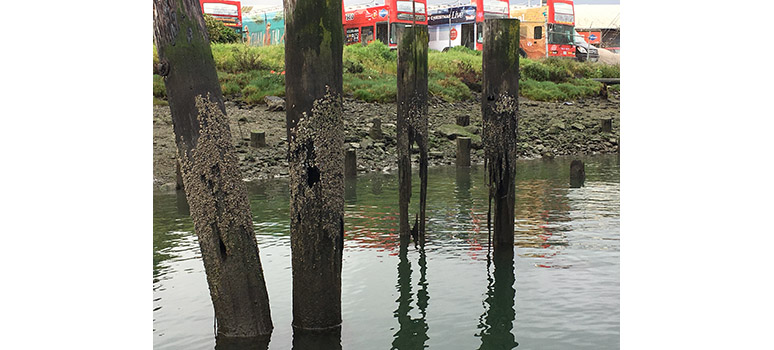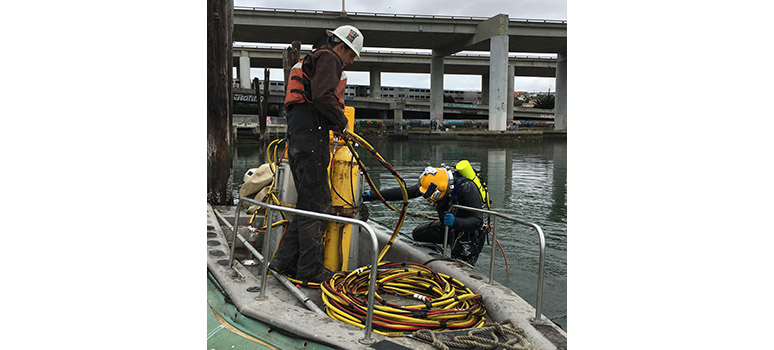The Port of San Francisco has removed dilapidated piles that once supported the piers along the shores of Islais Creek

Photo by Matt Valbusa
BY BILL PICTURE
Published: January, 2019
The Port of San Francisco has removed dilapidated piles that once supported the piers along the shores of Islais Creek—crumbling reminders of the important role the southern waterfront plays in San Francisco’s rich maritime history.
Abandoned for decades, when the last of the area’s slaughterhouses, canneries and agricultural processing plants cleared out, the piers fell into disrepair. Some were barely standing when the removal began last May. Others had crumbled and been reclaimed by the Bay, leaving behind wood piles that Port of San Francisco Superintendent of Harbor Maintenance Tim Felton refers to as “ghost piers.”
Cleanup efforts like this one along the southern waterfront are helping breathe new life into the area, whose long-vacant brick monoliths, once home to wartime shipbuilders and other waterfront-oriented industries, are now being called home by recognizable brands like Uber and Restoration Hardware. Still, Felton admits there’s a tiny part of him that was sad to see the old piers go.
“It’s definitely romantic to think about,” Felton said of the area’s past life as a working waterfront. “You can imagine the whistles sounding and dockworkers all over the place. Walking down through that part of the City is still like a trip back through history.”
Felton pointed out that Islais Creek was once referred to as “Blood Creek” by locals because of the nearly 100 or so slaughterhouses that lined its shores. That was in the last half of the 19th century. “A lot of the messier, dirty industries set up shop down there,” he said.
But as time took its toll on the left-behind piers, they began to pose a number of dangers that made their removal necessary. For starters, some leftover piles sat below the water line, which made navigating the channel dangerous for boaters who couldn’t see them. “And eventually the piles break free and wreak havoc,” Felton said.
As years loosen the creek bottom’s grip on the old wood piles, they become susceptible to big storms. And once dislodged by swells, currents can carry the piles out into the middle of the Bay.
“They end up in the shipping channels,” Felton said. “It’s not a big deal if one of the big cargo ships hits one, but it’s dangerous for the ferries and for smaller craft.”
More frequently, currents deposit the piles underneath one of the active piers further north, where they act as agitators in the churning, washing-machine-like waters underneath and knock loose plumbing and electrical infrastructure installed below the piers for the occupants above. “The piles weigh 1,000 pounds each, so the winds and tides basically turn them into giant battering rams,” Felton said.
How in the world?!?!
Removal of the ghost piers isn’t easy. Piers still intact (though barely) had to be carefully disassembled. And the piles, because they’re driven deep into the soil below (up to 100 feet), couldn’t simply be pulled out. Instead, Felton had to send the port’s dive team down with hydraulic saws to cut the piles, about 500 of them, down to mud level.
“We’d send the team out at high tide to do it,” he said. “And then they’d float the loose piles over to Pier 90 where a crane was used to pick them out of the water.” From there, the piles were transported to Pier 96, whose tenant was hired to handle the disposal. Cost for the disposal—just under $50,000—was paid for with money from a grant. The cost of the removal, a four-month process, was included in the port’s operating budget.
Back when wood was the go-to material for piles, the wood was soaked in creosote, a petroleum-based compound, to keep it from rotting. “A hundred years later, if you were to cut one of the old wood piles in half, you can still smell the creosote,” Felton says. While not hazardous per se, creosote-laden wood can’t be repurposed. For instance, it can’t be turned into garden mulch, which is the final use for a lot of reclaimed wood. Instead, it’s sent directly to a landfill. Only certain landfills will accept wood that’s been treated with creosote.
As for the port’s divers, Felton said that the project left little time for them to do much else.
“They were removing 15 piles a day, on average,” he said. The team is responsible for everything from the annual inspection of San Francisco’s seawalls and the thousands of piles along its waterfront to invasive species surveys.
“When someone wants to move a barge, they’re the ones that go down and inspect the hull to see what’s growing down there and make sure no invasive species get taken to another part of the Bay,” Felton explains. These inspections alone are enough to keep the dive team’s four members busy year-round, but Felton says they’re also regularly called upon by other agencies with various below-water needs.
“The police will call when a car goes off a pier and ask for our help,” he said. “That happens more often than you might think.” Lately, the dive team’s been receiving a lot of calls to help fish rented scooters out of the Bay. “I’m not sure how they end up there,” he said. “But it started happening so often that we eventually had to say, ‘Sorry, we can’t help you out.’ We’re just too busy. That’s why it took so long to get around to removing the ghost piers.”

The decaying piles often broke free, causing problems elsewhere in the Bay. Photo by Matt Valbusa

The Port of San Francisco’s dive team was able to remove about 15 piles a day. Photo by Matt Valbusa

